
DJI’s Geospatial Environment Online (GEO) software, designed to help pilots avoid flying drones in restricted areas, now automatically updates with temporary flight restrictions (TFRs) around wildfires, as well as other enhancements. The change comes at an opportune time: complaints of drones interfering with aerial firefighting equipment over the CA wildfires has been a frequent media topic, as drone naysayers find another reason for heavier regulations.
DJI, heavily involved in drone advocacy, has been a long-standing proponent of using technological fixes in place of more regulation. “Safety is DJI’s top priority, which is why we first introduced geofencing technology three years ago and have been steadily refining the industry’s best technology to enhance aviation safety,” said Brendan Schulman, DJI Vice President of Policy and Legal Affairs, who led the development of the new system. “Drone pilots want to fly safely, and our GEO system helps DJI customers fly responsibly while also enabling the full capabilities of remotely piloted aircraft.”
A DJI statement explains the new system: “GEO improves upon DJI’s earlier No-Fly Zone technology by including permanent restrictions around prisons, nuclear power plants and other sensitive locations, as well as temporary restrictions for large stadium gatherings and national security events. It also introduces flexibility for drone pilots by giving them the ability to unlock some restricted areas where they have permission to operate.”
GEO prevents flight in restricted zones such as airports unless a pilot with a verified DJI account temporarily unlocks it for a permissible use, ensuring that recreational drone operators do not unintentionally break the law. Some areas restricted due to national security issues – such as Washington, D.C. – cannot be unlocked.
The system covers 17 countries, including most of North America and western Europe, and is expanding rapidly. The GEO system is available for iOS systems and Android in the latest update of the DJI GO app, and operates on all Inspire models as well as the Phantom 4, Phantom 3 Professional and Phantom 3 Advanced models. Pilots who want to use the new system should update their app as well as the firmware for their controller and aircraft.

Miriam McNabb is the Editor-in-Chief of DRONELIFE and CEO of JobForDrones, a professional drone services marketplace, and a fascinated observer of the emerging drone industry and the regulatory environment for drones. Miriam has penned over 3,000 articles focused on the commercial drone space and is an international speaker and recognized figure in the industry. Miriam has a degree from the University of Chicago and over 20 years of experience in high tech sales and marketing for new technologies.
For drone industry consulting or writing, Email Miriam.
TWITTER:@spaldingbarker
Subscribe to DroneLife here.
